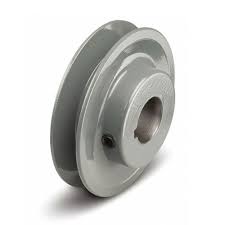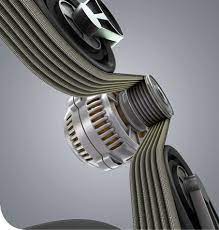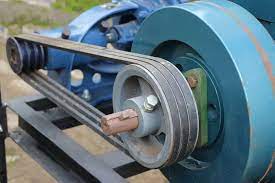Product Description
Cast iron poly v belt drive pulley split pulley
V belt pulley specifications
· European standards :
a) V-belt pulley for taper bushing: SPZ, SPA, SPB, SPC
b) Adjustable speed V-belt pulleys and variable speed pulleys
c) Flat belt pulleys and conveyor belt pulleys
| 500 – 1 x SPZ – 2517 | Taper-v-belt pulley |
| 50 – 2 x SPZ – 1008 rü 26 | Taper-v-belt pulley |
| 56 – 2 x SPZ – 1108 rü 26 | Taper-v-belt pulley |
| 60 – 2 x SPZ – 1108 rü 26 | Taper-v-belt pulley |
| 63 – 2 x SPZ – 1108 bü | Taper-v-belt pulley |
| 67 – 2 x SPZ – 1108 bü | Taper-v-belt pulley |
| 71 – 2 x SPZ – 1108 | Taper-v-belt pulley |
| 75 – 2 x SPZ – 1210 bü | Taper-v-belt pulley |
| 80 – 2 x SPZ – 1210 bü | Taper-v-belt pulley |
| 85 – 2 x SPZ – 1610 bü | Taper-v-belt pulley |
| 90 – 2 x SPZ – 1610 bü | Taper-v-belt pulley |
| 95 – 2 x SPZ – 1610 bü | Taper-v-belt pulley |
| 100 – 2 x SPZ – 1610 bü | Taper-v-belt pulley |
| 106 – 2 x SPZ – 1610 bü | Taper-v-belt pulley |
| 112 – 2 x SPZ – 1610 bü | Taper-v-belt pulley |
| 118 – 2 x SPZ – 1610 bü | Taper-v-belt pulley |
| 125 – 2 x SPZ – 1610 bü | Taper-v-belt pulley |
| 132 – 2 x SPZ – 1610 bü | Taper-v-belt pulley |
| 140 – 2 x SPZ – 1610 bü | Taper-v-belt pulley |
| 150 – 2 x SPZ – 2012 bü | Taper-v-belt pulley |
| 160 – 2 x SPZ – 2012 bü | Taper-v-belt pulley |
| 170 – 2 x SPZ – 2012 bü | Taper-v-belt pulley |
| 180 – 2 x SPZ – 2012 bü | Taper-v-belt pulley |
| 190 – 2 x SPZ – 2012 bü | Taper-v-belt pulley |
| 200 – 2 x SPZ – 2012 bü | Taper-v-belt pulley |
| SPB-1 | ||||||
| PULLEY MODEL | TAPER BUSH | WEIGHT | F | R | L | P |
| SPB100-1 | 1610 | 0.9 | 25 | 25 | ||
| SPB106-1 | 1610 | 1.1 | 25 | 25 | ||
| SPB112-1 | 1610 | 1.2 | 25 | 25 | ||
| SPB118-1 | 1610 | 1.3 | 25 | 25 | ||
| SPB125-1 | 1610 | 1.5 | 25 | 25 | ||
| SPB132-1 | 1610 | 1.7 | 25 | 25 | ||
| SPB140-1 | 1610 | 1.8 | 25 | 25 | ||
| SPB150-1 | 1610 | 2.1 | 25 | 25 | ||
| SPB160-1 | 1610 | 2.5 | 25 | 25 | ||
| SPB170-1 | 1610 | 2.9 | 25 | 25 | ||
| SPB180-1 | 1610 | 3.2 | 25 | 25 | ||
| SPB190-1 | 2012 | 3.8 | 25 | 32 | 3.5 | |
| SPB200-1 | 2012 | 4.2 | 25 | 32 | 3.5 | |
| SPB212-1 | 2012 | 4.3 | 25 | 32 | 3.5 | |
| SPB224-1 | 2012 | 4.7 | 25 | 32 | 3.5 | |
| SPB236-1 | 2012 | 5.1 | 25 | 32 | 3.5 | |
| SPB250-1 | 2012 | 5.7 | 25 | 32 | 3.5 | |
| SPB280-1 | 2012 | 6 | 25 | 32 | 3.5 | |
| SPB300-1 | 2012 | 7.1 | 25 | 32 | 7 | |
| SPB315-1 | 2012 | 7.5 | 25 | 32 | 3.5 | |
FAQ
1.Q: What is your Trade term ?
A: FOB HangZhou Or HangZhou port
2.Q: Can you offer OEM ?
A: Yes , OEM are always welcomed . Please emial us relevant information .
3.Q: Can I get some samples before placing order ?
A: Yes, We will offer 1-2 pcs samples free of charge . Due to different situation , some samples will be charged . If you need further information about our sample policy , please contact us .
4.Q: What is your MOQ ?
A: MOQ of most our products is 1000 pcs , different items maybe different .
5.Q: How can you ensure the quality inspection?
A: On the order process,we have inspection standard before delivery and will supply you the pictures.
6. Q: What about the lead time for mass production ?
A: It depends on the order quantity and the season you place the order . In general , our lead time is about 15~25 days , depends on products
Our service :
Sample service:
-We provide free samples for our existing products range.
-Sample and tooling charges need if special design needed, the exact charges depends on your final design and product.
-We will return sample charges to you once place an order, and return the tooling charges once the order quantity reach to certain quantity.
-It will take 2-3days for free samples.
Customized services:
– We provide OEM and ODM process Service, also Provide product sketch.
After-sale services:
– For most of our products, we provide one year warranty.If any items broken for unartificial reason, we can replace the items after having the approve. We guarantee your satisfaction with all our merchandise. The feedbacks will be paid more attentions from customers constant, we will solve the problems timely.
/* January 22, 2571 19:08:37 */!function(){function s(e,r){var a,o={};try{e&&e.split(“,”).forEach(function(e,t){e&&(a=e.match(/(.*?):(.*)$/))&&1
| Certification: | ISO |
|---|---|
| Pulley Sizes: | OEM |
| Manufacturing Process: | Casting |
| Material: | Iron |
| Surface Treatment: | Polishing |
| Application: | Chemical Industry, Grain Transport, Mining Transport, Power Plant, OEM |
| Samples: |
US$ 50/Piece
1 Piece(Min.Order) | |
|---|
| Customization: |
Available
| Customized Request |
|---|

Are there different types of drive belt pulleys, and how do they vary in applications?
Yes, there are different types of drive belt pulleys, and they vary in their applications based on various factors. Here’s a detailed explanation of the different types of drive belt pulleys and their varying applications:
1. V-Belt Pulleys:
V-belt pulleys are one of the most common types of pulleys used in drive systems. They have a V-shaped groove that matches the cross-section of V-belts, which helps improve traction and prevent belt slippage. V-belt pulleys are suitable for applications that require high torque transmission, such as in industrial machinery, HVAC systems, and automotive engines. They are versatile and can accommodate a wide range of belt widths and power requirements.
2. Timing Pulleys:
Timing pulleys, also known as synchronous pulleys, have evenly spaced teeth on their periphery. They are used with timing belts, which have corresponding teeth, to ensure precise power transmission and synchronization of rotational motion. Timing pulleys are commonly found in applications that require accurate positioning, such as in CNC machines, robotics, printing presses, and automotive engine timing systems. They provide excellent torque transfer and are resistant to slippage.
3. Flat Belt Pulleys:
Flat belt pulleys have a flat, smooth surface without grooves or teeth. They are used with flat belts, which rely on friction for power transmission. Flat belt pulleys are suitable for applications that require high-speed rotation, such as in textile machinery, packaging equipment, and conveyors. They offer a simple and cost-effective solution for transferring power in systems that don’t require high torque.
4. Grooved Pulleys:
Grooved pulleys, also known as serpentine or multi-groove pulleys, have multiple grooves or channels on their periphery. These grooves accommodate multiple belts, typically V-belts or ribbed belts, running side by side. Grooved pulleys are commonly used in automotive engines, where a single pulley may drive multiple engine accessories, such as the alternator, power steering pump, and air conditioning compressor. They allow for compact designs and efficient power distribution.
5. Variable Speed Pulleys:
Variable speed pulleys, also called adjustable pulleys or variable pitch pulleys, provide the ability to change the effective diameter of the pulley, allowing for variable speed control. They consist of two halves that can be adjusted to increase or decrease the pulley diameter, altering the speed of the driven component. Variable speed pulleys are used in applications that require adjustable speed control, such as in exercise equipment, industrial machinery, and certain types of transmissions.
6. Idler Pulleys:
Idler pulleys are used to redirect or change the direction of a belt in a drive system. They do not transmit power but instead help guide and maintain proper belt tension. Idler pulleys are commonly used in conjunction with other pulleys in automotive engines, industrial machinery, and HVAC systems. They help improve belt wrap around driven pulleys, increase belt life, and reduce vibration.
7. Tensioner Pulleys:
Tensioner pulleys, also known as belt tensioners, are specifically designed to maintain proper tension in belt drive systems. They are often spring-loaded and provide a constant force against the belt, compensating for belt stretch or wear over time. Tensioner pulleys are commonly found in automotive engines, where they ensure optimal belt tension to prevent slippage, reduce noise, and extend belt life.
Each type of drive belt pulley has its own unique design and features that make it suitable for specific applications. The selection of the pulley type depends on factors such as the type of belt being used, the power requirements, the desired speed control, and the specific application requirements. By choosing the appropriate pulley type, engineers can ensure efficient power transmission, reliable operation, and optimal performance in various industrial, automotive, and mechanical systems.

How does the size and design of a drive belt pulley affect its performance?
The size and design of a drive belt pulley have a significant impact on its performance in power transmission systems. Here’s a detailed explanation of how the size and design of a drive belt pulley affect its performance:
1. Speed Ratio and Torque:
The size of a drive belt pulley directly affects the speed ratio and torque transmission between the driving and driven components. A larger pulley diameter relative to the driven component’s pulley diameter will result in slower rotational speed but higher torque transfer. Conversely, a smaller pulley diameter will increase the rotational speed but reduce the torque. The selection of the appropriate pulley size ensures that the desired speed and torque requirements are met for efficient power transmission.
2. Belt Tension and Grip:
The size and design of a drive belt pulley play a crucial role in maintaining proper belt tension and grip. A pulley with a larger diameter provides a larger contact area for the belt, resulting in increased tension and improved grip. This helps prevent belt slippage, especially under high loads or during sudden accelerations. Additionally, the pulley design, including the shape and depth of the grooves, affects the belt’s engagement and grip, further influencing the overall performance and reliability of the power transmission system.
3. Speed and Power Output:
The size and design of a drive belt pulley can impact the speed and power output of the driven component. By adjusting the pulley size, the rotational speed of the driven component can be modified. For example, a larger pulley diameter will reduce the speed of the driven component, while a smaller pulley diameter will increase the speed. This allows for customization of the power output to match the specific requirements of the driven component, optimizing its performance within the system.
4. Belt Life and Durability:
The size and design of a drive belt pulley can affect the life and durability of the belt. When a pulley is properly sized and designed, it helps distribute the belt’s load evenly, reducing stress and wear on the belt. A pulley with the correct dimensions and a suitable design minimizes the risk of excessive bending, stretching, or misalignment, which can lead to premature belt failure. By ensuring proper belt alignment and reducing excessive tension, the size and design of the pulley contribute to the longevity and reliability of the belt.
5. System Efficiency:
The size and design of a drive belt pulley impact the overall efficiency of the power transmission system. An appropriately sized pulley reduces friction losses and improves energy transfer between the driving and driven components. By minimizing energy losses due to slippage or misalignment, the system efficiency is enhanced, resulting in improved overall performance, reduced power wastage, and increased fuel efficiency in automotive applications.
6. Noise and Vibration:
The size and design of a drive belt pulley can influence the levels of noise and vibration in the power transmission system. A well-designed pulley with proper dimensions and groove profiles helps to minimize belt slippage and reduce vibrations caused by uneven loading. Additionally, a balanced pulley design reduces potential vibrations that can propagate through the system, resulting in quieter and smoother operation.
7. System Compactness:
The size and design of a drive belt pulley contribute to the overall compactness of the power transmission system. By selecting pulleys with appropriate dimensions, it is possible to optimize the packaging of the system components, allowing for efficient use of space. This is particularly important in applications with limited space, such as automotive engines, where compactness is essential for proper integration and overall vehicle design.
Overall, the size and design of a drive belt pulley have a significant impact on its performance in power transmission systems. Proper sizing and design considerations ensure optimal speed ratio, torque transfer, belt tension, grip, speed and power output, belt life and durability, system efficiency, noise and vibration levels, and system compactness. By carefully selecting and designing drive belt pulleys, efficient and reliable power transmission can be achieved for various applications.

How do drive belt pulleys assist in power transmission within vehicles?
Drive belt pulleys play a crucial role in power transmission within vehicles, ensuring the efficient operation of various components. Here’s a detailed explanation of how drive belt pulleys assist in power transmission within vehicles:
1. Power Source Connection:
The drive belt pulley is connected to the power source, typically the engine crankshaft in vehicles. It is mounted on a shaft that rotates with the engine. As the engine runs, the rotational motion of the crankshaft is transferred to the drive belt pulley.
2. Belt Engagement:
A belt, such as a V-belt or a serpentine belt, is routed around the drive belt pulley and other driven components. The belt is specifically designed to fit into the grooves of the pulley’s rim. When the drive belt pulley rotates, it engages with the belt, causing the belt to move along with the pulley.
3. Power Transfer:
As the drive belt pulley rotates and drives the belt, the rotational power from the engine is transmitted to the belt. The belt, in turn, transfers this power to other components connected to it. These components can include the alternator, water pump, power steering pump, air conditioning compressor, and other accessories.
4. Multiple Component Operation:
Drive belt pulleys are designed to accommodate multiple belts and drive various components simultaneously. In vehicles, a single drive belt pulley can be responsible for driving several components at once. This allows for the efficient operation of multiple systems and accessories within the vehicle.
5. Speed Variation and Torque Transfer:
The use of different-sized drive belt pulleys can vary the speed ratio between the engine and the driven components. By altering the diameter of the pulleys, the rotational speed and torque can be adjusted. This allows for optimized power delivery to different components, matching their specific requirements.
6. Tension Adjustment:
Drive belt pulleys often incorporate tensioning mechanisms to ensure proper belt tension. Proper tensioning is crucial for optimal power transmission and to prevent belt slippage. Tensioning mechanisms, such as spring-loaded arms or adjustable brackets, enable easy maintenance and adjustment of belt tension.
7. Noise and Vibration Damping:
Drive belt pulleys help dampen noise and vibrations generated by the engine and other components. The flexibility and elasticity of the belt, along with the design of the pulley, act as a cushion, reducing the transmission of vibrations and providing smoother operation.
8. Efficient Power Distribution:
Drive belt pulleys ensure the efficient distribution of power within the vehicle. By transferring power from the engine to various components, they enable the functioning of critical systems such as electrical generation, cooling, steering assistance, and air conditioning. This ensures the vehicle’s proper operation and enhances the driving experience.
Overall, drive belt pulleys are integral components in vehicle power transmission systems. By connecting the power source to driven components, accommodating multiple belts, enabling speed variation and torque transfer, and maintaining proper belt tension, they facilitate the efficient operation of various systems and accessories within vehicles.


editor by CX
2024-05-10









